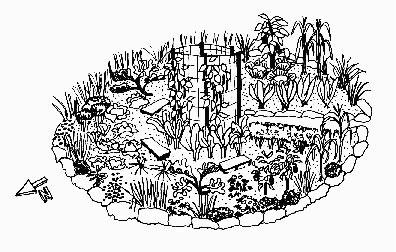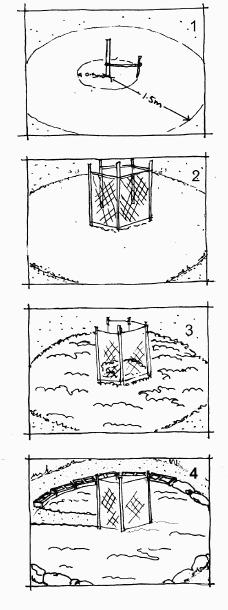Home Life Earth Fire Water
Constructing a
CIRCULAR VEGETABLE GARDEN

This circular vegetable garden is attractive enough to be placed in the smallest front garden. It is ideal for growing salad vegetables and herbs. Edible flowers can add colour and attract pollinators. The most important factor in the success of the garden is its siting. It occupies a space approximately 3m X 3m and this should be in full sun for most of the growing season. In the subtropics, afternoon shade in summer will help reduce wilting in leafy vegetables.
The garden consists of a compost bin at the centre, surrounded by the vegetables and edged with herbs. The compost bin is placed in the centre of the circle so that the dissolved nutients from it are evenly distributed throughout the garden. Kitchen scraps , shredded paper, leaves and seed-free weeds can be placed in the bin. An occasional layer of manure will help to keep the compost forming and a layer of straw on top keeps it moist.
Once the garden is established, only the compost is watered, so that the nutient-rich water is drawn out by the plants. There is in effect a constant supply of liquid fertiliser available to plants. This garden is not heavily mulched between the plants as the mulch would stop the moisture from the bin being drawn out to the plants. Instead, the plants are placed close together so that they shade the soil and prevent weed growth. Any unplanted areas should be mulched until they are used as well as around young seedlings until they are established.
Almost any vegetable can be grown in the garden. However, tomatoes (except dwarf varieties), pumpkins, melons and potatoes take up too much room. Peas and climbing beans can be grown on the wire mesh of the compost bin. Lower growing vegetables should generally be kept to the north and tall plants to the south to minimise shading. Plant types should be rotated around the garden as in any other vegetable patch. Onions, garlic and shallotts make a good insect repellant border to the garden.
CONSTRUCTION
Materials:
5 or 6 star pickets, 3.5m fencing mesh, tie wire, 1 bag dolomite or gypsum (on acid soils), 1 bag chicken manure, 9.5 m garden edging
 |
- Drive a stake into the center of the proposed garden. Attach one end of a rope to the stake and a pointed stick to the other end. Use this giant compass to scribe a circle of 0.5m radius (the compost bin) and another of 1.5m radius (the outer edge of the garden).
- Remove the turf from the central circle. Drive 5 or 6 stakes or star pickets evenly spaced around the circle. Leave the south side open for access and attach the fencing mesh to the stakes with tie wire, Replace the turf, upside down, in the base of the bin.
- Remove the turf from the outside circle and use elsewhere or add it to the compost bin. Dig over the soil and sprinkle dolomite or gypsum over it if neccessary. Three weeks later, dig in a bag of manure. The garden is now ready for planting.
- The garden can be finished off with an edging of rochs or concrete blocks. The blocks make good planters for smaller herbs like thyme or marjoram. A path around the garden gives easier accedd and stops weed invasion, especially grass from surrounding lawns.
|
Home Life Earth Fire Water

